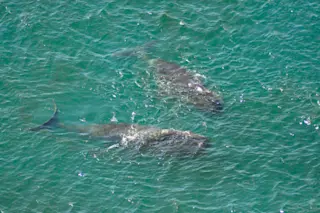On land the penguin is waddling and ungainly. But in the depths of the frigid Antarctic Ocean, the birds swim with power and grace, often traveling in shoulder-to-shoulder formations. Akinori Takahashi of Hokkaido University in Japan discovered this unexpected aquatic choreography using unique “penguin cams,” 2.6-ounce digital cameras taped onto the backs of five Adélie and five chinstrap penguins. The cameras snapped images every 15 seconds (a total of over 11,000 images) and took regular depth measurements. The results showed that penguins dive with one to 11 partners 15 percent of the time overall—and much more often when they go below 75 feet.
Diving en masse may benefit a penguin for several reasons, Takahashi thinks. Penguins might increase their foraging efficiency by coordinating their efforts. By being part of a group with many pairs of watchful eyes, a penguin might also increase the odds of spotting seals or other predators ...














